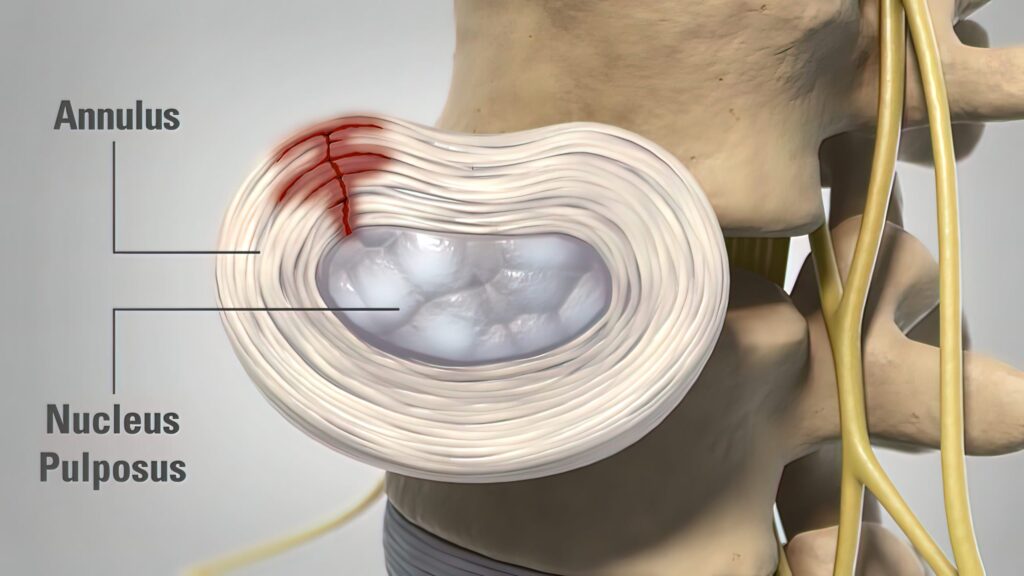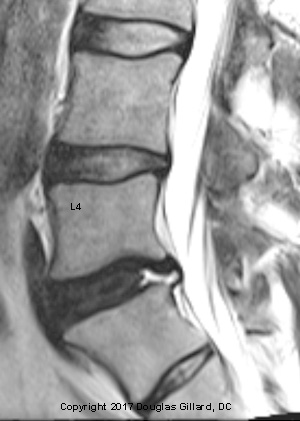Common Conditions
Annular Tears (High Signal Zones)
An annular tear is a small tear or fissure in the outer layer (annulus fibrosus) of an intervertebral disc. These discs provide both flexibility and shock absorption between the adjacent vertebrae. When the tough outer layer of a disc develops a tear, the inner gel-like material (nucleus pulposus) may push outward and create a disc bulge or occasionally rupture. As the nerve supply of a disc is on its outer surface, tears in the peripheral disc edge can are more likely to be painful. Annular tears are sometimes referred to as high signal zones (HSZs) because they can appear as bright areas on certain MRI scans due to fluid accumulation within the tear.

What causes annular tears?
Annular tears can develop due to several factors, including:
- Age-related degeneration: As discs naturally degenerate over time, they become more prone to develop annular tears.
- Repetitive stress: Activities that involve heavy lifting, twisting, or prolonged sitting can contribute to disc injury including annular tearing.
- Trauma or injury: A fall, car accident, or sudden movement can cause a tear in the annulus fibrosus.
- Genetic factors: Some individuals may have a predisposition to disc disease, making them more susceptible to annular tears.
Common symptoms of annular tears
Annular tears are commonly seen on MRI and may cause symptoms including:
- Localized pain: A dull or sharp pain in any region of the spine, depending on the location of the tear. Sometimes, annular tears cause an episodic low back pain – a pattern of pain with episodes of severe pain with little discomfort in between.
- Pain aggravated with movement: Bending, twisting, or sitting for long periods can increase discomfort from an annular tear.
- Radiating pain: If the tear weakens a disc, it may lead to a bulging or herniated disc that presses on spinal nerves, which results in referred pain, weakness or numbness.
- Numbness or tingling: If annular tears are near spinal nerves, patients may experience tingling or numbness in the affected limb. This is thought to be due to nerve inflammation (local neuritis) rather than compression.
Diagnosis of annular tears
Annular tears are commonly diagnosed on MRI and are not seen on other imaging modalities.
These appear as high-intensity zones (HIZs) or bright areas on certain MRI sequences that indicate fluid in a torn disc.
In rare cases, a test called discography may be used to diagnose painful annular tears which are suspected and cause painful internal disc derangement. This involves injecting contrast dye into the disc to see if it typical pain is reproduced. As discography may not alter clinical management, and has specific risks including pain and infection, it should only be undertaken rare circumstances. Around 50% of annular tears are not thought to be a cause of any symptoms, and because symptoms overlap with many other spinal conditions, these tears should only be diagnosed as significant by an experienced spinal specialist after thorough clinical assessment in conjunction with MRI imaging.

Management of annular tears
Only treat annular tears if they are thought to be the main cause of symptoms. The most important treatments are focussed on symptom relief. In the fullness of time, most annular tears do heal but this may take years. Occasionally they progress and lead to disc rupture.
- Conservative management:
Rest and avoiding activities that aggravate symptoms. - Medications:
— Over-the-counter analgesics including anti-inflammatories or paracetamol.
— Prescription medications or muscle relaxants for more severe pain. - Physical and exercise therapy:
Exercises to strengthen the spinal core muscles that support the spine can improve posture and helps to offload the discs. It is important to note that specific core rehabilitation exercises will take weeks to have any benefit. Therapies such as massage, dry needling, acupuncture and TENs machines do not treat the underlying condition but may help pain in the short term. - Injections:
CT Guided corticosteroid injections near the affected disc can help reduce inflammation and pain from annular tears – but the response is often temporary lasting several months. Guided local anaesthetic/corticosteroid injections can sometimes be used to help diagnose an annular tear in certain circumstances. - Lifestyle modifications:
Practising good posture, using ergonomic seating, good lifting technique and maintaining a healthy body weight can reduce stress on the spinal discs and may reduce pain from an annular tear. - Surgery (rare cases):
Annular tears cannot be surgically repaired. Very rarely surgical options such as a discectomy or spinal fusion may be considered.

